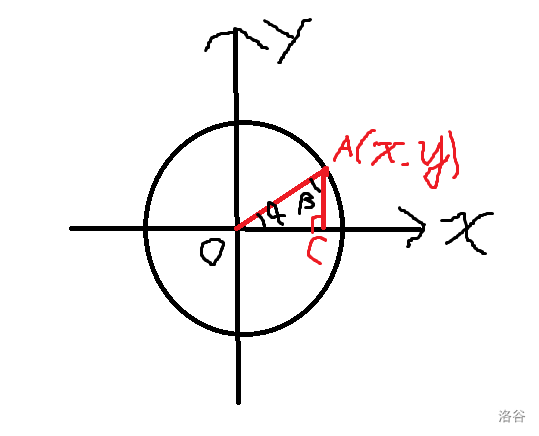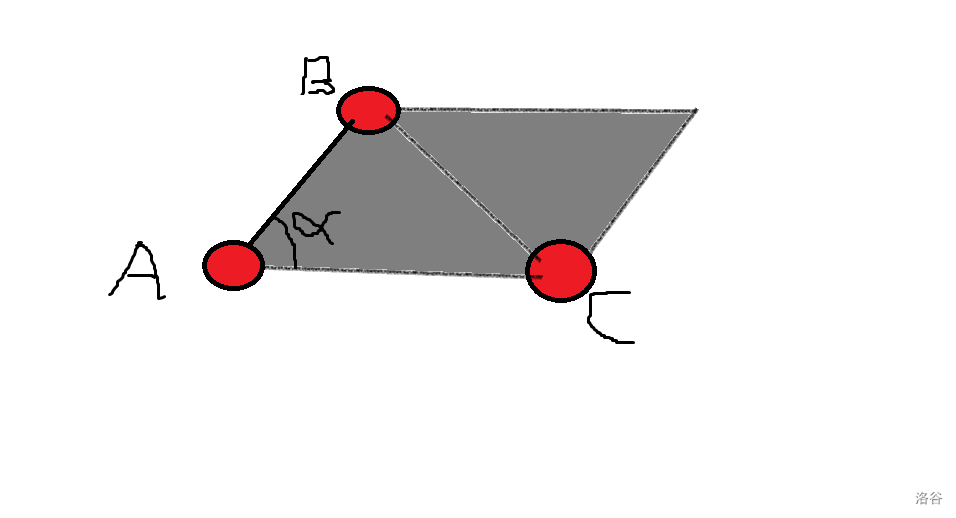题解 HDU3629【Convex】
计算几何大杂侩!今天是平面几何,明天呢?
problem
平面上 \(n\) 个点满足两点不重合,三点不共线,求有多少个凸的四边形。\(n\leq 700\)。
以下 prework 会的同学可以跳过()就我不会()
prework:三角函数初步
(好吧就今天中午刚学的做个学习笔记而已)

如图在平面直角坐标系中,\(\bigodot O\) 的半径为 \(1\),点 \(A(x,y)\) 在圆上,\(AC\perp OC\) 与点 \(C\)。这意味着 \(OC=x,AC=y\),对吗?
三角函数的定义
- \(\sin\alpha\) 表示以 \(\alpha\) 为一个角的直角三角形中 对边比斜边 的比值。
- \(\cos\alpha\) 表示以 \(\alpha\) 为一个角的直角三角形中 邻边比斜边 的比值。
- \(\tan\alpha\) 表示以 \(\alpha\) 为一个角的直角三角形中 对边比邻边 的比值。
这个定义是可以推广的,只要是个角就行。
性质一:三角函数与单位圆
- \(\sin\alpha=\frac{AC}{OA}=\frac{y}{1}=y\)。
- \(\cos\alpha=\frac{OC}{OA}=\frac{x}{1}=x\)。
- \(\tan\alpha=\frac{AC}{OC}=\frac{y}{x}\)。不在单位圆上也适用。
结论:\(\tan\) 是意外,\(\sin,\cos\) 才是一对
也就是说 \(A(\cos\alpha,\sin\alpha)\),同时 \(\tan\alpha=\frac{\sin\alpha}{\cos\alpha}\)。
性质二:三角函数与勾股定理
由勾股定理得,\(AC^2+OC^2=OA^2\)(即 \(x^2+y^2=1\) 发现了吗?),也就是 \(\sin^2\alpha+\cos^2\alpha=1\)。
性质三:三角函数的增减性
随着点 \(A\) 的移动,在 \(0^\circ<\alpha<90^\circ\)(\(0<\alpha<\frac{\pi}{2}\))时,随着点 \(A\) 的纵坐标增加,显然横坐标在递减,也就是说:
- \(x\) 递减:\(\cos\alpha\) 递减。
- \(y\) 递增:\(\sin\alpha\) 递增。
- \(\tan\alpha=\frac{y}{x}\) 递增。
性质四:三角函数余角公式
在图中我们声明了 \(\beta=\angle OAC\),显然因为是直角三角形所以 \(\alpha+\beta=\frac{\pi}{2}\),观察:
- \(\sin\beta=x=\cos\alpha=\frac{OC}{OA}\)。
- \(\cos\beta=y=\sin\alpha=\frac{AC}{OA}\)。
- \(\tan\beta\cdot\tan\alpha=1\)。
差不多了。
prework:极角排序与 std::atan2
给平面选定一个原点,那么每个点都能以 方位角 + 距离的形式被唯一的表示。我们称所谓的方位角为极角。
现在对于一个点 \(A(x,y)\),我们要求它的极角,即 \(OA\) 与 \(x\) 轴的夹角,怎么求呢?
刚刚说了 \(\tan\alpha=\frac{y}{x}\),我们相当于求一个 \(\alpha\) 使得 \(\tan\alpha=\frac{y}{x}\)。
这里用 \(\tan\) 的反函数 \(\arctan\) 求出 \(\alpha\)。在 C++ 标准库中已经有一个 std::atan2 可以使用,调用 atan2(y,x) 即可求出它的极角。在这里我们不太关心正负,只要有序的转一圈就行了,不用刻意的调整。
prework:极角排序与叉积
我们只要它绕一圈就行了,要求不高。考虑叉积。
这里我们先确定这个点的象限,如果象限不同比较编号,否则直接叉积,看一下是否大于零。
sort(b+1,b+n+1,[&](dot<LL> a,dot<LL> b){
auto quad=[](dot<LL> a){
if(a.x>0&&a.y>=0) return 0;
if(a.x<=0&&a.y>0) return 1;
if(a.x<0&&a.y<=0) return 2;
if(a.x>=0&&a.y<0) return 3;
return -1;
};
return quad(a)==quad(b)?a*b>0:quad(a)<quad(b);
});
prework:向量
定义
为了写程序方便,引入向量 \(\vec{a}=(x,y)\)。\(\vec{a}\) 本质上是一个点的偏移量,因此我们不关心它的起点是什么,可以减,例如两个点 \(A=(x_1,y_1),B=(x_2,y_2)\),有向线段可以表示为向量 \(\vec{AB}=(x_2-x_1,y_2-y_1)\)。注意到令 \(O=(0,0)\) 为原点,\(\vec{OA}=(x,y)=A\) 因此向量可以用点的方式存储。
令 \(\vec{a}=(x_1,y_1),\vec{b}=(x_2,y_2)\),定义一些运算:
- 向量模长:\(|\vec{a}|=\sqrt{x^2+y^2}\).
- 向量加法:\(\vec{a}+\vec{b}=(x_1+x_2,y_1+y_2)\)。
- 向量减法:\(\vec{a}-\vec{b}=(x_1-x_2,y_1-y_2)\)。
- 向量数乘:\(\lambda\vec{a}=(\lambda x,\lambda y)\)。
- 向量点乘:\(\vec{a}\cdot\vec{b}=x_1x_2+y_1y_2\)。
- 向量叉乘:\(\vec{a}\times\vec{b}=x_1y_2-x_2y_1\)。
叉积
重点看叉积,我们声明其符号为 \(\times\):

如图,当 \(\alpha\leq180^\circ\) 时,\(\vec{AC}\times\vec{AB}\geq 0\),也就是这个灰色的平行四边形的面积,或者说是:
- \(\vec{AC}\) 绕点 \(A\) 逆时针旋转到 \(\vec{AB}\) 所扫过的平行四边形的面积。
如果反过来 \(\vec{AB}\times\vec{AC}\leq 0\) 就是 \(\vec{AB}\) 反过来(顺时针)转到 \(\vec{AC}\) 扫过的平行四边形面积的相反数。
以下是一些小性质:
- \(\vec a\times\vec b=X_aY_b-X_bY_a\)(定义)。
- 两个起点不同的向量要叉乘,可以将其中一个向量平移,使两个向量起点相同就可以叉乘。
- \(\vec a\times \vec b=-\vec b\times\vec c\)。没有交换律。
- \(a//b\Leftrightarrow\vec a\times \vec b=0\)。
这里提供一个板子:
template<class T=double> struct dot{
T x,y;
dot(T x=0,T y=0):x(x),y(y){}
dot operator+(dot b){return dot(x+b.x,y+b.y);}//向量加
dot operator-(dot b){return dot(x-b.x,y-b.y);}//向量减
dot operator*(T k){return dot(x*k,y*k);}//数乘,或叫放缩
T operator*(dot b){return x*b.y-b.x*y;}//叉乘
T operator^(dot b){return x*b.x+y*b.y;}//点乘,对应坐标相乘
friend T dist(dot a){return sqrt(a^a);}//绝对值 / 模长,即到原点的距离
};
solution 0:\(O(n^4)\)
复习一下凸多边形的判定:选定一条边后,其它所有点都在这条边所在的直线的同一侧。
于是可以用叉积写出暴力了()
具体一点:点 \(A,B,C,D\),枚举 \(\vec{AB}\) 是一条边,则 \(\vec{AB}\times\vec{AC}\) 与 \(\vec{AB}\times\vec{AD}\) 符号相同(注意到三点不共线)。
注意一些小细节:算重 \(8\) 次(枚举每条边和方向)
Code
typedef long long LL;
template<class T=double> struct dot{
T x,y;
dot(T x=0,T y=0):x(x),y(y){}
dot operator+(dot b){return dot(x+b.x,y+b.y);}
dot operator-(dot b){return dot(x-b.x,y-b.y);}
dot operator*(T k){return dot(x*k,y*k);}
T operator*(dot b){return x*b.y-b.x*y;}
T operator^(dot b){return x*b.x+y*b.y;}
friend T dist(dot a){return sqrt(a^a);}
};
int n;
dot<LL> a[510];
LL ans=0;
bool check(int i,int j,int x,int y){
auto sgn=[](LL x)->int{return !x?0:(x<0?-1:1);};
return sgn((a[j]-a[i])*(a[x]-a[i]))*sgn((a[j]-a[i])*(a[y]-a[i]))>0;
}
int main(){
scanf("%d",&n);
for(int i=1;i<=n;i++) scanf("%lld%lld",&a[i].x,&a[i].y);
for(int i=1;i<=n;i++){
for(int j=1;j<=n;j++){
if(i==j) continue;
for(int k=1;k<=n;k++){
if(i==k||j==k) continue;
for(int l=1;l<=n;l++){
if(l==i||l==j||l==k) continue;
ans+=check(i,j,k,l)&&check(j,k,l,i)&&check(k,l,i,j)&&check(l,i,j,k);
}
}
}
}
printf("%lld\n",ans>>3);
return 0;
}
solution 1:\(O(n^3)\)
考虑不算凸四边形,我们算凹(āo)四边形的数量。
枚举两个点 \(A,B\),再找两个点 \(C,D\),如果 \(C,D\) 在 \(AB\) 所在直线的异侧就说明四边形 \(ABCD\) 一定不是凸四边形,而是凹四边形。
所以枚举两个点,记 \(AB\) 左边(任意一边都行)有 \(c_0\) 个点,右边有 \(c_1\) 个点,则贡献 \(c_0\cdot c_1\) 个凹四边形。
而四边形一共有 \(\binom{n}{4}\) 个,所以答案是 四边形的个数 减去 凹四边形的个数。
Code
typedef long long LL;
template<class T=double> struct dot{
T x,y;
dot(T x=0,T y=0):x(x),y(y){}
dot operator+(dot b){return dot(x+b.x,y+b.y);}
dot operator-(dot b){return dot(x-b.x,y-b.y);}
dot operator*(T k){return dot(x*k,y*k);}
T operator*(dot b){return x*b.y-b.x*y;}
T operator^(dot b){return x*b.x+y*b.y;}
friend T dist(dot a){return sqrt(a^a);}
};
int n;
LL ans;
dot<LL> a[510];
int main(){
scanf("%d",&n);
for(int i=1;i<=n;i++) scanf("%lld%lld",&a[i].x,&a[i].y);
ans=1ll*n*(n-1)*(n-2)*(n-3)>>3;
for(int i=1;i<=n;i++){
for(int j=i+1;j<=n;j++){
LL cnt[2]={0,0};
for(int k=1;k<=n;k++){
if(i==k||j==k) continue;
debug("i=%d,j=%d,k=%d,*=%lld\n",i,j,k,(a[k]-a[j])*(a[i]-a[j]));
if((a[k]-a[j])*(a[i]-a[j])>0) cnt[0]++;
else cnt[1]++;
}
ans-=cnt[0]*cnt[1];
}
}
printf("%lld\n",ans);
return 0;
}
solution 2:\(O(n^2\log n)\)
还是考虑求凹四边形,考虑它的形状,大概是一个三角形(三角形没有凹凸之分)里面有一个点的样子。
枚举三角形的中心点,现在我们要找有多少个三角形包含它。
还是容斥:总方案数是 \(\binom{n-1}{3}\),要求不包含中心点的三角形。
假设中心点是 \(O\),枚举一个点 \(A\),作直线 \(OA\)。在 \(OA\) 一侧的点,选出两个,加上点 \(A\) 就是一个三角形。正确的,因为不存在三点共线。
考虑极角排序之后,点 \(A\) 继续往下枚举,这条直线也在旋转,枚举所有点之后刚好转一圈,于是可以维护这条直线转到哪(类似单调队列优化),一遍扫过去,均摊的线性。
极角排序使用喜欢的算法做()但是判断平角这个部分可以说一下:
- 叉乘的写法是
a*b>0。 std::atan2的写法是angle(a,b)<PI,其中 \(PI=\pi=\arccos(-1)\),angel求两个角度的差,注意写法:
要判一下减爆的情况,加个周角 \(2\pi\)。double angel(double a,double b){ return a>=b?a-b:a-b+2*PI; }
Code(`std::atan2`)
#include <cmath>
#include <cstdio>
#include <cstring>
#include <algorithm>
using namespace std;
#ifdef LOCAL
#define debug(...) fprintf(stderr,##__VA_ARGS__)
#else
#define debug(...) void(0)
#endif
typedef long long LL;
const double PI=acos(-1);
LL C(LL n,int m){
switch(m){
case 1: return n;
case 2: return n*(n-1)/2;
case 3: return n*(n-1)/2*(n-2)/3;
case 4: return n*(n-1)/2*(n-2)/3*(n-3)/4;
}
return -1;
}
template<class T=double> struct dot{
T x,y;
dot(T x=0,T y=0):x(x),y(y){}
dot operator+(dot b){return dot(x+b.x,y+b.y);}
dot operator-(dot b){return dot(x-b.x,y-b.y);}
dot operator*(T k){return dot(x*k,y*k);}
T operator*(dot b){return x*b.y-b.x*y;}
T operator^(dot b){return x*b.x+y*b.y;}
friend T dist(dot a){return sqrt(a^a);}
};
int n;
dot<LL> a[510];
double b[510];
double angel(double a,double b){
return a>=b?a-b:a-b+2*PI;
}
LL calc(int n){//不包含中心点的凸三角形个数
LL ans=0;
for(int l=1,r=0;l<=n;l++){//枚举一个点
while(r+1<l+n&&angel(b[r%n+1],b[l])<PI) r++;//不超过一个平角
ans+=C(r-l,2);
}
return ans;
}
LL solve(){//凹包个数
LL ans=0;
for(int i=1;i<=n;i++){//枚举中转点
for(int j=1;j<=n;j++) if(i!=j) b[j-(j>i)]=atan2(a[j].y-a[i].y,a[j].x-a[i].x);
sort(b+1,b+n);
ans+=C(n-1,3)-calc(n-1);
}
return ans;
}
int main(){
// #ifdef LOCAL
freopen("trick.out","w",stdout);
freopen("trick.in","r",stdin);
// #endif
scanf("%d",&n);
for(int i=1;i<=n;i++) scanf("%lld%lld",&a[i].x,&a[i].y);
printf("%lld\n",C(n,4)-solve());
return 0;
}
Code(叉积)
#include <cmath>
#include <cstdio>
#include <cstring>
#include <algorithm>
using namespace std;
#ifdef LOCAL
#define debug(...) fprintf(stderr,##__VA_ARGS__)
#else
#define debug(...) void(0)
#endif
typedef long long LL;
const double PI=acos(-1);
LL C(LL n,int m){
switch(m){
case 1: return n;
case 2: return n*(n-1)/2;
case 3: return n*(n-1)/2*(n-2)/3;
case 4: return n*(n-1)/2*(n-2)/3*(n-3)/4;
}
return -1;
}
template<class T=double> struct dot{
T x,y;
dot(T x=0,T y=0):x(x),y(y){}
dot operator+(dot b){return dot(x+b.x,y+b.y);}
dot operator-(dot b){return dot(x-b.x,y-b.y);}
dot operator*(T k){return dot(x*k,y*k);}
T operator*(dot b){return x*b.y-b.x*y;}
T operator^(dot b){return x*b.x+y*b.y;}
friend T dist(dot a){return sqrt(a^a);}
};
int n;
dot<LL> a[510],b[510];
LL sgn(LL x){return !x?0:(x<0?-1:1);}
LL calc(int n){//不包含中心点的凸三角形个数
LL ans=0;
for(int l=1,r=0;l<=n;l++){//枚举一个点
while(r+1<l+n&&b[l]*b[r%n+1]>=0) r++;//不超过一个平角
//注意自己叉自己是合法的
ans+=C(r-l,2);
}
return ans;
}
LL solve(){//凹包个数
LL ans=0;
for(int i=1;i<=n;i++){//枚举中转点
for(int j=1;j<=n;j++) if(i!=j) b[j-(j>i)]=a[j]-a[i];
sort(b+1,b+n,[&](dot<LL> a,dot<LL> b){
auto quad=[](dot<LL> a){
if(a.x>0&&a.y>=0) return 0;
if(a.x<=0&&a.y>0) return 1;
if(a.x<0&&a.y<=0) return 2;
if(a.x>=0&&a.y<0) return 3;
return -1;
};
return quad(a)==quad(b)?a*b>0:quad(a)<quad(b);
});
// for(int j=1;j<n;j++) printf("%.3lf\n",atan2(b[j].y,b[j].x));
// puts("=======");
//调试小细节:如果你写对了,这里输出 atan2 的值应该是两个递增的序列拼在一起
ans+=C(n-1,3)-calc(n-1);
}
return ans;
}
int main(){
// #ifdef LOCAL
freopen("trick.in","r",stdin);
// #endif
freopen("trick.out","w",stdout);
scanf("%d",&n);
for(int i=1;i<=n;i++) scanf("%lld%lld",&a[i].x,&a[i].y);
printf("%lld\n",C(n,4)-solve());
return 0;
}
solution 3:\(O(n^3\log n)\)
枚举对角线,左右两边的点分别求出夹角 \((\alpha_x,\beta_x)\),那么相当于要找两个在异侧的点满足 \(\alpha_x+\alpha_y<\pi\land\beta_x+\beta_y<\pi\)。
CDQ 分治。
本文来自博客园,作者:caijianhong,转载请注明原文链接:https://www.cnblogs.com/caijianhong/p/solution-HDU3629.html


